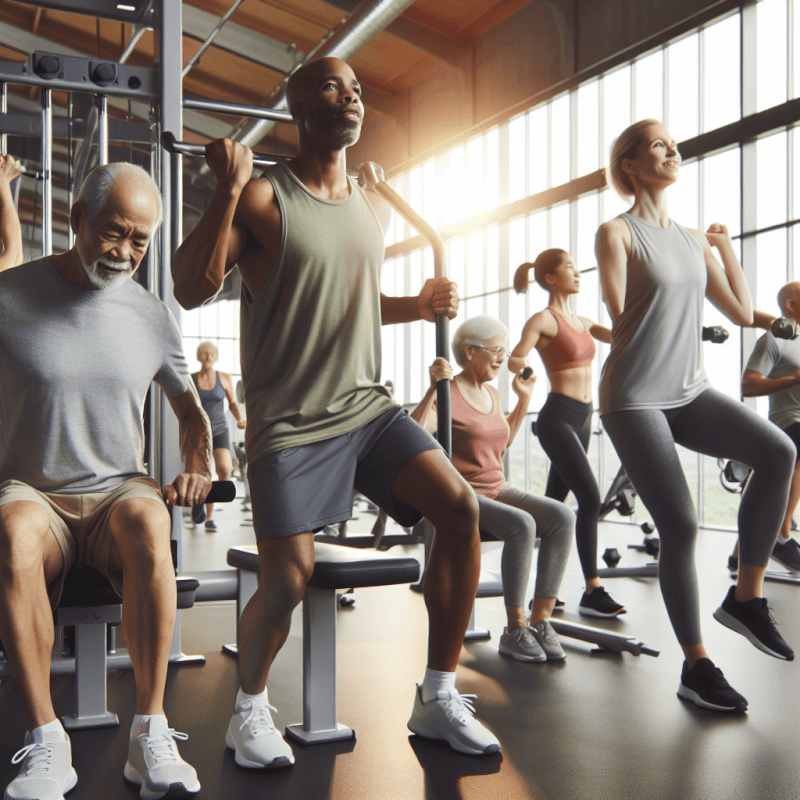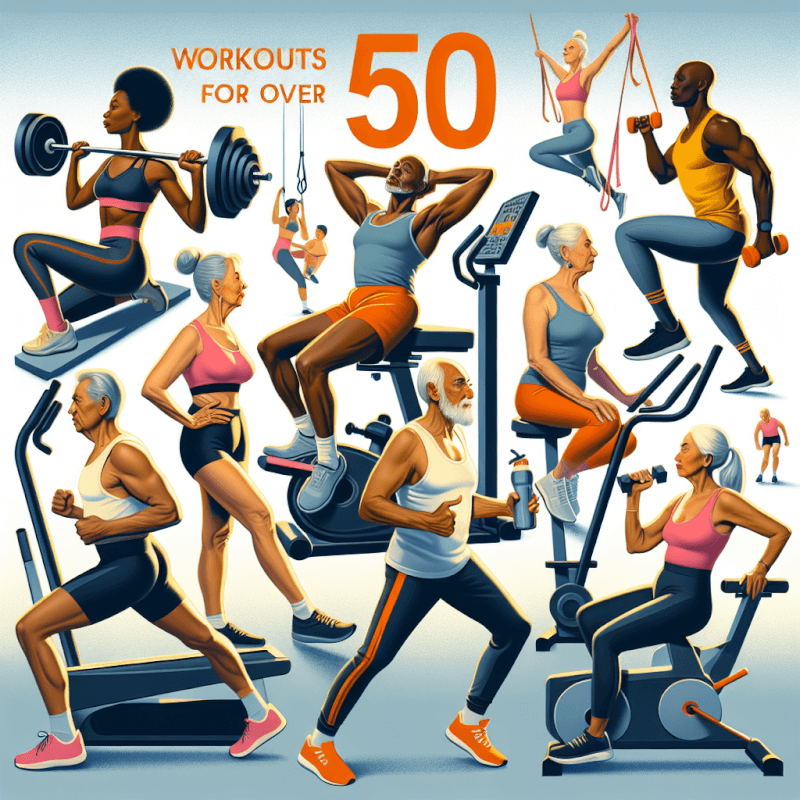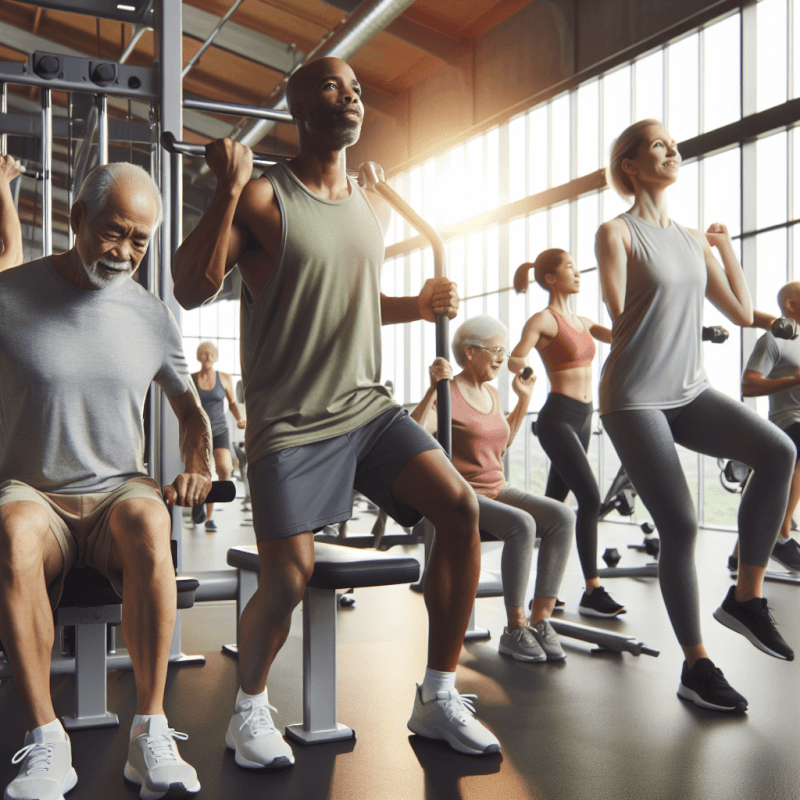Hey there! If you’re a fabulous 50+ individual looking to stay active and fit, we’ve got just the thing for you. In this article, we’ll be sharing some amazing gym workouts specifically designed for those over 50. Whether you’re a fitness enthusiast or just starting out, these exercises will help you build strength, boost your energy levels, and keep you feeling vibrant. So put on your workout gear and let’s dive into some fantastic gym routines that are perfect for all you amazing 50+ folks out there!
Cardiovascular Exercises
Benefits of Cardiovascular Exercises
Cardiovascular exercises, also known as cardio or aerobic exercises, play a crucial role in maintaining good health and well-being, especially for individuals over 50. Engaging in regular cardiovascular exercise offers several benefits, including improved heart health, increased lung capacity, weight management, reduced risk of chronic diseases such as heart disease, high blood pressure, and type 2 diabetes, and enhanced mood and mental well-being. These exercises also help boost endurance and overall stamina, allowing you to maintain an active lifestyle as you age.
Types of Cardiovascular Workouts
There is a wide range of cardiovascular workouts that you can incorporate into your fitness routine. Some popular options for individuals over 50 include walking, jogging or running, swimming, cycling or using a stationary bike, dancing, low-impact aerobics, and using cardio machines such as ellipticals or stair climbers. It is important to choose an exercise that you enjoy and that matches your fitness level and any underlying medical conditions. Remember to start slowly and gradually increase the intensity and duration of your workouts.
How to Incorporate Cardiovascular Exercises into your Gym Routine
Incorporating cardiovascular exercises into your gym routine is fairly simple and can be a great way to add variety to your workouts. You can allocate dedicated days for cardio workouts or combine them with other forms of exercise. For example, you can start your gym session with a 10-15 minute warm-up on the treadmill or stationary bike. Alternatively, you can opt for a dedicated cardio class such as Zumba or water aerobics. It is important to aim for at least 150 minutes of moderate-intensity aerobic exercise or 75 minutes of vigorous-intensity aerobic exercise each week, spread out over several days. This can help you meet the American Heart Association’s guidelines for cardiovascular health.
Strength Training
Importance of Strength Training for Older Adults
Strength training is vital for individuals over 50 as it helps preserve and build muscle mass, increase bone density, improve joint stability, enhance metabolism, and promote overall functional fitness. As we age, muscle mass naturally declines, which can lead to reduced strength, balance issues, and an increased risk of falls and fractures. Engaging in strength training exercises can counteract this decline, improve overall physical performance, and enhance the ability to perform daily tasks with ease and independence.
Different Types of Strength Training
Strength training encompasses various modalities that can be tailored to suit your preferences and fitness level. Traditional weightlifting using dumbbells, barbells, or resistance machines is a popular option. Alternatively, bodyweight exercises such as push-ups, squats, and lunges can be performed anywhere, making them convenient for home workouts. Other forms of strength training include resistance band exercises, suspension training with devices like TRX, and functional movements that mimic everyday activities. It is essential to choose exercises that target all major muscle groups, including the legs, arms, back, chest, and core, for a well-rounded strength training routine.
Safety Tips for Strength Training
Prioritizing safety is crucial when engaging in strength training, especially for older adults. Start by consulting with a qualified fitness professional or your healthcare provider to determine the appropriate exercises and resistance levels for your fitness level and any pre-existing medical conditions. Proper form and technique are essential to prevent injuries and optimize the effectiveness of your workouts. Start with lighter weights or resistance and gradually increase the intensity as you become more comfortable and proficient. Additionally, incorporating a warm-up and cool-down routine, stretching before and after workouts, and allowing adequate rest and recovery days are all important factors in maintaining a safe and effective strength training routine.
Creating a Strength Training Routine
Building a personalized strength training routine can be done with the help of a fitness professional or through self-guided research. It is essential to include exercises that target all major muscle groups, such as squats, lunges, chest presses, rows, shoulder presses, and core exercises like planks. Aim to perform strength training exercises at least two days a week, with a day of rest between sessions to allow your muscles to recover and adapt. Gradually increase the resistance or weight used as you become stronger, and consider incorporating progressive overload principles, such as increasing repetitions or sets, to continue challenging your muscles. Remember to listen to your body and modify exercises as needed to avoid excessive strain or discomfort.

Flexibility and Stretching
Why Flexibility Matters for Over 50
Maintaining flexibility is crucial for individuals over 50 as it helps improve joint range of motion, enhances posture, reduces muscle stiffness, and decreases the risk of injuries. As we age, our muscles naturally become less pliable, which can lead to decreased mobility and increased muscle imbalances. Flexibility exercises can mitigate these issues, improve overall functional performance, and enable you to perform daily activities with greater ease and comfort.
Types of Stretching Exercises
There are two main types of stretching exercises: static and dynamic. Static stretching involves holding stretches for a certain duration without bouncing, focusing on lengthening and relaxing the muscles. This type of stretching is great for improving and maintaining overall flexibility. Dynamic stretching, on the other hand, involves moving the joints and muscles through a controlled range of motion, using active movements that gradually increase in intensity. Dynamic stretching is often used as part of a warm-up routine to prepare the body for exercise. Both static and dynamic stretching have their place in a well-rounded flexibility routine.
How to Stretch Safely
When performing static stretches, it is important to hold each stretch for approximately 15-30 seconds, aiming for a feeling of gentle tension rather than pain. Avoid bouncing or jerking during the stretch, as this can increase the risk of strain or injury. Focus on breathing deeply and relaxing into the stretch. Dynamic stretching should be performed in a controlled manner, ensuring that movements are within a comfortable range and avoiding any sudden or jerky motions that may strain the muscles or joints. If you have any specific muscle imbalances or concerns, consider working with a qualified fitness professional or physical therapist who can provide guidance and tailor a stretching routine to meet your individual needs.
Incorporating Flexibility Work in your Gym Workouts
To incorporate flexibility exercises into your gym workouts, allocate dedicated time before and after your main workout for stretching. Before exercise, focus on dynamic stretches that target the muscles and joints you will be using during your workout. This helps to warm up the body, increase blood flow, and prepare the muscles for activity. After your workout, utilize static stretches to help cool down the body, release muscle tension, and improve overall flexibility. Consider attending yoga or Pilates classes, which can incorporate both dynamic and static stretching exercises in a structured and guided format. If you prefer solo workouts, you can follow a stretching routine that targets all major muscle groups or use stretching equipment such as foam rollers or resistance bands to assist in your stretches.
Balance and Stability
Importance of Balance and Stability Exercises
As we age, maintaining good balance and stability becomes increasingly important to reduce the risk of falls and injuries. Balance and stability exercises help develop strong muscles, improve coordination, enhance proprioception (awareness of your body’s position in space), and boost confidence in performing daily activities. By incorporating these exercises into your fitness routine, you can significantly improve your ability to maintain balance, prevent falls, and enjoy an active and independent lifestyle.
Exercises to Improve Balance and Stability
There are several exercises that can enhance balance and stability. One popular exercise is the single-leg stance, where you stand on one leg for a period of time while maintaining your balance. Another effective exercise is heel-to-toe walk, where you walk in a straight line placing one foot directly in front of the other, heel to toe. Tai chi and yoga are also great options as they incorporate flowing movements and poses that challenge your balance and stability. Additionally, exercises that target the muscles of the hips, glutes, and core, such as squats, lunges, and planks, can also help improve balance and stability.
Tips for Enhancing Stability
When performing balance and stability exercises, it is important to start with exercises that match your current ability level. Begin with exercises that allow you to maintain balance with minimal support and gradually progress to more challenging exercises as you become stronger and more confident. Utilizing props such as balance boards, stability balls, or resistance bands can also add an extra challenge to your workouts. Incorporating exercises that mimic real-life movements, such as reaching for objects on various heights or walking on uneven surfaces, can further enhance stability by preparing your body for everyday situations. Be patient with yourself and remember that balance and stability improve with practice and consistency.
Adding Balance Training to your Gym Routine
To incorporate balance and stability exercises into your gym routine, allocate dedicated time for these exercises on a regular basis. Begin your workout with a few simple balance exercises to warm up the muscles and prepare your body for movement. This can include exercises like standing on one leg, performing gentle toe taps, or practicing controlled weight shifts. As you progress, add more challenging exercises such as standing on an unstable surface, like a balance disc or foam pad, or trying yoga or tai chi classes that specifically focus on balance and stability. Incorporating strength exercises that target the muscles responsible for balance, such as hip abductors or core exercises, can further enhance stability and overall functional fitness.

Core Workouts
Benefits of Core Workouts
Having a strong and stable core is essential for individuals over 50 as it plays a vital role in maintaining good posture, preventing lower back pain, and enhancing overall functional movement. Core exercises help strengthen the muscles of the abdomen, lower back, hips, and pelvis, which provide support and stability to the spine and contribute to proper alignment and efficient movement patterns. A strong core also improves balance and coordination, making it easier to perform activities of daily living and engage in sports or recreational activities.
Exercises for Strengthening the Core
There are numerous exercises that can help strengthen and tone the core muscles. Some popular options include planks, crunches, Russian twists, bicycle crunches, and bridges. Planks are particularly effective as they engage multiple muscle groups simultaneously, including the abdominals, lower back, and shoulders. To perform a plank, start by lying face down on the floor. Lift your body off the ground, resting on your toes and forearms, while maintaining a straight line from your head to your heels. Hold this position for as long as you can, gradually increasing the duration with practice. It is important to note that variations and modifications of these exercises can be done to suit different fitness levels and any existing back or spine conditions.
Tips for Engaging the Core Muscles
Proper form and technique are key when performing core exercises for maximum benefit and to minimize the risk of injury. Focus on engaging the deep abdominal muscles, such as the transverse abdominis, by drawing the belly button towards the spine. This helps to activate the core muscles and provide stability to the spine. Avoid straining the neck or shoulders during exercises by maintaining a relaxed and neutral position. Breathe deeply and consistently throughout each exercise, allowing the diaphragm to move freely and the core muscles to stabilize the torso. Gradually increase the intensity and duration of your core workouts as your strength improves, ensuring that you maintain proper form throughout.
Incorporating Core Work into your Gym Workouts
To incorporate core workouts into your gym routine, allocate dedicated time for core exercises at least two to three times a week. You can choose to perform these exercises as a standalone routine or incorporate them into your existing workout sessions. Begin with a few basic exercises, such as planks or bridges, and gradually add more challenging exercises as your core strength improves. To target different areas of the core, include exercises that focus on the upper abdominals, lower abdominals, obliques, and lower back muscles. Utilize equipment such as stability balls or medicine balls to add variety and increase the intensity of your core workouts. Consider joining a Pilates or core-focused class to gain further guidance and structure in your core training.
Joint-Friendly Workouts
Importance of Joint-Friendly Exercises
Engaging in joint-friendly exercises is crucial for individuals over 50 as it helps protect the joints, maintain flexibility, reduce pain and inflammation, and improve overall joint health. Joint-friendly exercises are low-impact and place minimal stress on the joints, making them suitable for individuals with arthritis, joint pain, or any existing joint conditions. By incorporating these exercises into your fitness routine, you can maintain an active lifestyle while minimizing the risk of joint discomfort or injury.
Low-Impact Exercises to Protect Joints
There are plenty of low-impact exercises that can help protect your joints while still providing a challenging workout. Walking is an excellent low-impact exercise that can be done anywhere and requires minimal equipment. Swimming and water aerobics are also great options as the buoyancy of the water reduces the impact on the joints. Cycling on a stationary bike or using an elliptical machine provides a cardiovascular workout with minimal stress on the joints. Low-impact strength training exercises such as using resistance bands or performing bodyweight exercises can also help build strength without putting excessive strain on the joints.
Tips for Reducing Joint Strain
To reduce joint strain during workouts, it is important to listen to your body and modify exercises as needed. Choose exercises that do not exacerbate any existing joint discomfort or pain. If a particular exercise causes discomfort, consider modifying it or choosing an alternative exercise that targets the same muscle groups. It is also advisable to use proper form and technique during exercises to minimize stress on the joints. Using equipment such as supportive shoes, knee braces, or wrist wraps can provide additional stability and reduce joint strain during workouts. Lastly, consider incorporating regular rest days into your fitness routine to allow for adequate recovery and joint repair.
Designing a Joint-Friendly Gym Routine
When designing a joint-friendly gym routine, prioritize exercises that are gentle on the joints while still providing a comprehensive workout. Begin with a gentle warm-up routine that includes dynamic movements to increase blood flow and warm up the joints. Focus on low-impact cardiovascular exercises, such as walking on the treadmill or using a stationary bike, for your aerobic workouts. Strength training can also be performed using low-impact exercises, such as resistance band exercises, yoga, or Pilates. Incorporate gentle stretching exercises to improve flexibility and reduce muscle tension. Consulting with a fitness professional or physical therapist can be beneficial in designing a personalized joint-friendly gym routine that addresses your specific needs and limitations.

Full Body Circuit Training
Benefits of Full Body Circuit Training
Full body circuit training is an efficient and effective way to work out the entire body, combining cardiovascular exercises with strength training for a comprehensive workout. This type of training helps improve cardiovascular fitness, build strength, increase muscular endurance, and burn calories. Full body circuit training is also time-efficient, making it ideal for individuals with busy schedules. By performing exercises in a circuit format, you can keep your heart rate elevated while simultaneously targeting different muscle groups, resulting in a robust and challenging workout.
Exercises to Include in a Circuit Workout
A full body circuit workout should include a combination of cardiovascular exercises, strength training exercises, and dynamic movements. Consider incorporating exercises such as jump rope, mountain climbers, burpees, or stair climbing for cardiovascular conditioning. For strength training, integrate compound exercises that target multiple muscle groups simultaneously, such as squats, lunges, push-ups, rows, shoulder presses, and deadlifts. Additionally, including dynamic movements such as medicine ball slams, kettlebell swings, or battle rope exercises can further challenge your muscles and elevate the intensity of your circuit workout.
Creating Your Own Circuit Training Routine
Creating your own circuit training routine allows you to tailor the exercises and intensity to match your fitness level and preferences. Start by selecting three to six different exercises that target various muscle groups and cardiovascular fitness. Perform each exercise in a consecutive circuit format, completing a set number of repetitions for each exercise before moving on to the next. Aim to complete the circuit two to three times, with minimal rest periods between exercises and longer rest periods between circuits. As your fitness level improves, gradually increase the number of circuits or the intensity of the exercises. Incorporate a mix of high-intensity exercises and lower-intensity exercises to ensure a well-rounded workout.
Safety Precautions for Circuit Training
Although circuit training can be highly beneficial, it is important to prioritize safety during your workouts. Begin each circuit with a proper warm-up to increase blood flow, enhance flexibility, and prepare the body for exercise. Pay attention to proper form and technique, especially when performing compound movements that involve multiple muscle groups. If an exercise feels too challenging or causes pain or discomfort, modify or eliminate that exercise from your routine. Allow yourself adequate rest and recovery time between circuits to prevent overexertion and reduce the risk of injury. Lastly, listen to your body and adjust the intensity or duration of your circuit training as needed.
Functional Training
Advantages of Functional Training
Functional training focuses on improving strength, stability, and mobility through exercises that mimic everyday movements and activities. It emphasizes training the body for real-life activities, enabling individuals to perform daily tasks with greater ease and reducing the risk of injuries. Functional training can improve overall balance, coordination, flexibility, and posture. By incorporating these exercises into your fitness routine, you can enhance your ability to maintain an active lifestyle and engage in activities that bring you joy and fulfillment.
Functional Exercises for Over 50
Functional exercises for individuals over 50 can target different areas of mobility and strength to improve overall functional fitness. Examples of functional exercises include squats, lunges, step-ups, push-ups, planks, and kettlebell swings. These exercises engage multiple muscle groups simultaneously and mimic movements required for activities such as getting in and out of chairs, climbing stairs, or lifting grocery bags. When performing functional exercises, focus on maintaining proper form and technique to ensure safety and effectiveness. Consider working with a fitness professional who specializes in functional training to receive personalized guidance and progressions.
Incorporating Functional Movements into your Gym Workouts
To incorporate functional movements into your gym workouts, identify exercises that mirror movements you perform in daily life. Consider utilizing free weights, resistance bands, or bodyweight exercises to engage multiple muscle groups in a functional manner. For example, instead of using a leg press machine, opt for squats or lunges to improve lower-body strength and stability. Rather than using weight machines for upper-body exercises, try push-ups or resistance band rows to incorporate more functional movements. It can also be beneficial to join functional fitness classes that focus on movements and exercises specific to everyday activities. By consistently integrating functional exercises into your gym routine, you can enhance your overall functional fitness and improve your quality of life.

Group Fitness Classes
Benefits of Group Fitness Classes
Group fitness classes provide numerous benefits, especially for individuals over 50. First and foremost, they offer social interaction and a sense of community, making workouts more enjoyable and motivating. Group fitness classes also provide structure and guidance, with qualified instructors leading the sessions and offering modifications or adaptations as needed. These classes cater to a variety of fitness levels, allowing individuals to progress at their own pace and challenge themselves appropriately. Additionally, the variety of class formats and exercises can help prevent boredom and provide a well-rounded workout experience.
Types of Group Classes Suitable for Older Adults
There is a wide range of group fitness classes suitable for older adults, catering to various interests and fitness goals. Low-impact aerobic classes, water aerobics, and dance-based classes like Zumba are excellent options for cardiovascular conditioning without excessive joint stress. Strength training classes using resistance bands, light weights, or bodyweight exercises can help improve muscle tone and strength. Yoga classes can improve flexibility, balance, and reduce stress levels. Tai chi and Pilates classes are also popular options, emphasizing controlled movements, breath control, and core strength. It is important to choose classes that align with your fitness level, interests, and any specific health considerations.
Choosing the Right Class for Your Fitness Goals
When selecting a group fitness class, consider your personal fitness goals, interests, and any physical limitations or medical conditions. If you aim to improve cardiovascular fitness, look for classes that incorporate aerobic exercises or dance movements. For strength training, opt for classes that focus on resistance training or weightlifting. Yoga or Pilates classes can enhance flexibility, balance, and core strength. It is also important to consider the class schedule and location, choosing classes that fit conveniently into your routine. Attend trial classes or speak to the instructor beforehand to ensure the class aligns with your preferences and fitness needs.
Maximizing the Benefits of Group Fitness
To maximize the benefits of group fitness classes, it is important to attend regularly and commit to consistent attendance. This allows you to build a routine, progress in your fitness goals, and establish connections with fellow class participants. Arrive a few minutes early to set up and familiarize yourself with the equipment or setup. Communicate with the instructor about any physical limitations or concerns, and ask for modifications or assistance when needed. Listen to your body during the class and modify exercises as necessary to avoid overexertion or injury. Lastly, enjoy the camaraderie and positive energy of the class, knowing that you are taking a positive step towards improving your health and well-being.
Recovery and Mobility
Importance of Recovery and Mobility for Older Adults
Recovery and mobility are crucial aspects of overall fitness and well-being, especially for individuals over 50. Proper recovery techniques and mobility exercises help reduce muscle soreness, prevent injuries, enhance joint health, and promote overall mobility and flexibility. As we age, our bodies naturally take longer to recover from physical activity, making it essential to prioritize recovery and mobility to maintain an active lifestyle and avoid setbacks.
Recovery Techniques to Incorporate after Workouts
There are various techniques that can be incorporated into your post-workout routine to support effective recovery. Cooling down with light aerobic exercises or stretching can help lower the heart rate and relax the muscles. Applying ice or cold packs to any sore or inflamed areas can reduce swelling and alleviate muscle soreness. Rest and sleep are also vital components of recovery, allowing the body to repair damaged tissues and restore energy levels. It is important to listen to your body and take rest days as needed to prevent overtraining and burnout. Adequate hydration, proper nutrition, and consuming foods rich in nutrients and antioxidants can also support recovery and help replenish the body’s resources.
Enhancing Mobility through Stretching and Exercises
To enhance mobility, it is important to incorporate stretching and mobility exercises into your regular fitness routine. Dynamic stretches and active mobility exercises that involve moving the joints through their full range of motion are particularly effective. These exercises can include arm circles, leg swings, or torso twists. Yoga and Pilates classes can also provide structured stretching and mobility exercises that target the entire body. Foam rolling or using a massage ball can help release tight muscles and improve flexibility. Additionally, adding exercises that focus on joint mobility, such as shoulder circles or ankle rotations, can help improve overall joint health and mobility.
Prioritizing Recovery and Mobility in your Gym Routine
To prioritize recovery and mobility in your gym routine, allocate dedicated time for cool-down exercises and stretching after each workout. Aim to stretch all major muscle groups, holding each stretch for 15-30 seconds. Utilize props such as foam rollers, massage balls, or stretching bands to assist in your stretches and enhance muscle release. Consider participating in yoga or Pilates classes at the gym to receive guided instruction and gain knowledge of effective stretching and mobility exercises. Allow yourself adequate rest and recovery days between intense workout sessions to prevent overuse injuries. By incorporating recovery techniques and mobility exercises into your gym routine, you can optimize your overall fitness and well-being.
In conclusion, gym workouts for individuals over 50 should encompass a variety of exercises that cater to cardiovascular health, strength training, flexibility, balance, core strength, joint health, functional fitness, group fitness, and recovery. By incorporating these different aspects into your fitness routine, you can enhance your overall fitness, maintain an active lifestyle, and promote well-being as you age. Remember to always listen to your body, consult with a qualified fitness professional or healthcare provider, and make modifications or adjustments as necessary to suit your individual needs and abilities.



